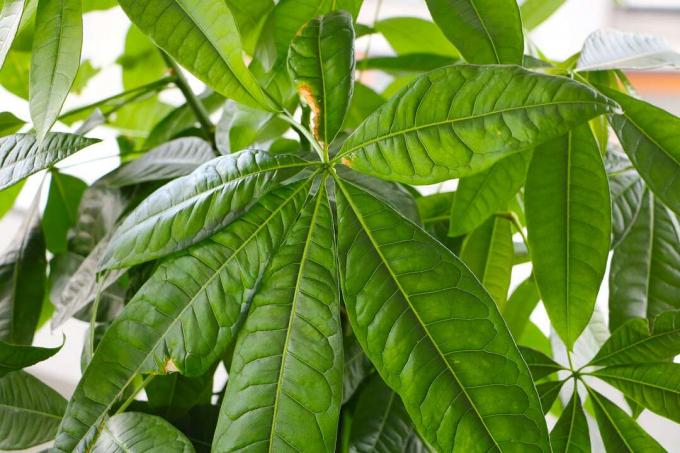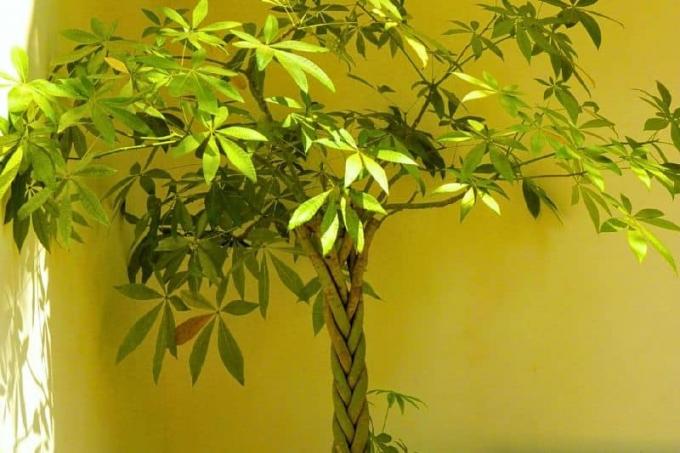
The extremely decorative lucky chestnut can grow very old if cared for properly. The location is also crucial for healthy growth. Below are some tips on how to find the ideal location for your lucky chestnut.
To the point
- ideal location bright and warm
- avoid direct sunlight
- Temperatures between 18 and 25 degrees desired
- Possible to move outside in summer
- needs high humidity
Table of contents
- Bright and warm
- Off to the open air
- frequently asked Questions
Bright and warm
The Lucky chestnut (Pachira aquatica), also commercially available under the name Pachira macrocarpa, originally comes from the tropical areas of Mexico, Peru and Brazil. The tree with a straight or braided trunk and a densely growing tree crown consisting of shiny palmate leaves, reaches a height of 20 meters in its native land. In this country it only grows to a height of 100 to 200 centimeters in the room. What is important, however, is the ideal location for the lucky chestnut. Due to the origin, you should note the following:
- Bright all year round, but no blazing sun
- direct sunlight causes leaf burns
- Temperatures between 18 and 25 degrees
- high humidity between 40 and 50 percent, plus
- Spray twice a week with lukewarm water

The lucky chestnut is considered shade tolerant. However, it grows slower in partial shade. A good spot is right next to a north window. It is light and the Pachira is spared from the sun. If it is in a south-facing window, the lucky chestnut definitely needs protection from direct sunlight. The lucky chestnut also dislikes frequent changes of location. It reacts sensitively by dropping leaves. You should only turn the Pachira to the light regularly, otherwise it will grow crooked.
A notice: In Asia, the lucky chestnut is considered a symbol of luck and prosperity.
Off to the open air
In summer, the lucky chestnut can also move into a sheltered place outdoors. She can spend here from the end of May to September. Getting used to the outdoors must be done gradually. The ideal location for the lucky chestnut is here:
- no sun, but bright
- ideally a place in light partial shade
- Temperatures not below 12 degrees and not above 24 degrees
- Protection from rain, wind and drafts

If temperatures consistently fall below 12 degrees in September, the Pachira has to move back indoors. In winter it needs to be kept a little cooler. If possible, you should therefore not choose a place in the heated living room. Temperatures between 12 and 18 degrees are now sufficient. However, they should not fall below 12 degrees. Here the small tree reacts by dropping leaves.
Our tip:Specimens that have become too large can tolerate pruning. After a few weeks they sprout again. The best time for cutting is spring.
frequently asked Questions
The root ball of the lucky chestnut must never dry out completely. It loves even soil moisture, but not waterlogging. Water can be stored in the thickened trunk base. Therefore, excessive moisture can become problematic. The frequency of watering depends on the plant size and room temperature. Smaller specimens are dived once a week. To do this, place the plant in a filled bucket of water until no more air bubbles are visible. Larger plants are watered once a week.
For good growth it needs Houseplant regular fertilizer applications. The administration takes place weekly from March to October. In winter, fertilization once a month is sufficient. A nutrient deficiency can be recognized by light-colored foliage. Special green plant fertilizer can be used. Fertilizer sticks have also proven useful. These provide the lucky chestnut with all the necessary nutrients for three months.
Repotting is necessary after two to three years. Then the root ball has usually completely grown through the substrate. Not only is a larger pot chosen, but a complete replacement of the substrate is necessary. The roots must not be left behind. The best time is spring.
There is no need to worry, the pachira is not poisonous. Their fruits and leaves are even edible. From the small tree goes for No danger to adults and pets out of. However, small children should not come into contact with the plant as the plant juices contained in the stem are slightly poisonous. Symptoms of poisoning may occur if consumed.

